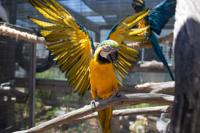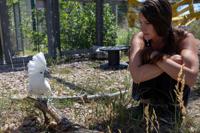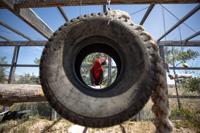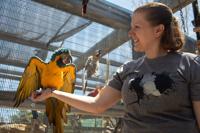Colorado parrot rescue, sanctuary home to more than 300 birds
R2FicmllbCBGb3VuZGF0aW9uIHN0YWZmZXIgS2ltYmVybHkgUGllcnNvbiBob2xkcyBvbnRvIGEgcmVkIGFuZCBncmVlbiBtYWNhdywgd2hpY2ggaXMgbmF0aXZlIHRvIE1leGljbyBhbmQgTGF0aW4gQW1lcmljYSwgaW4gYW4gb3V0ZG9vciBlbmNsb3N1cmUgYXQgdGhlIHNhbmN0dWFyeSBuZWFyIHRoZSB0aW55IHRvd24gb2YgRWxpemFiZXRoLiBEZXBlbmRpbmcgb24gdGhlIHR5cGUsIHBhcnJvdHMgY2FuIGxpdmUgdG8gYmUgdXAgdG8gODAgeWVhcnMgb2xkLg==
cGhvdG9zIGJ5IEpvaG4gU3RlbWJlciwgVGhlIEdhemV0dGU=
ELIZABETH • There is a place where the macaws head bob in unison to random songs, the African grey parrots sound like bells and an umbrella cockatoo named Lady Anna happily wears a cowgirl hat.
Pull into the dirt parking lot at The Gabriel Foundation, where more than 35 acres are devoted to the longtime parrot rescue and sanctuary in western Elbert County, near the tiny town of Elizabeth, and prepare to immerse yourself in “Days of Our Birds,” a soapy, aviary drama not yet ready for prime time. You’ll hear them before you see them, as they scream and yell, contact call to each other and attempt to sing.
Bird Call: No backyard? No problem. Try live bird cams
“Within their relationships they have little squabbles,” said Kimberly Pierson, The Gabriel Foundation’s avian welfare multimedia coordinator. “They’re moody like toddlers, and they’re silly. It’s a roller coaster with a parrot.”
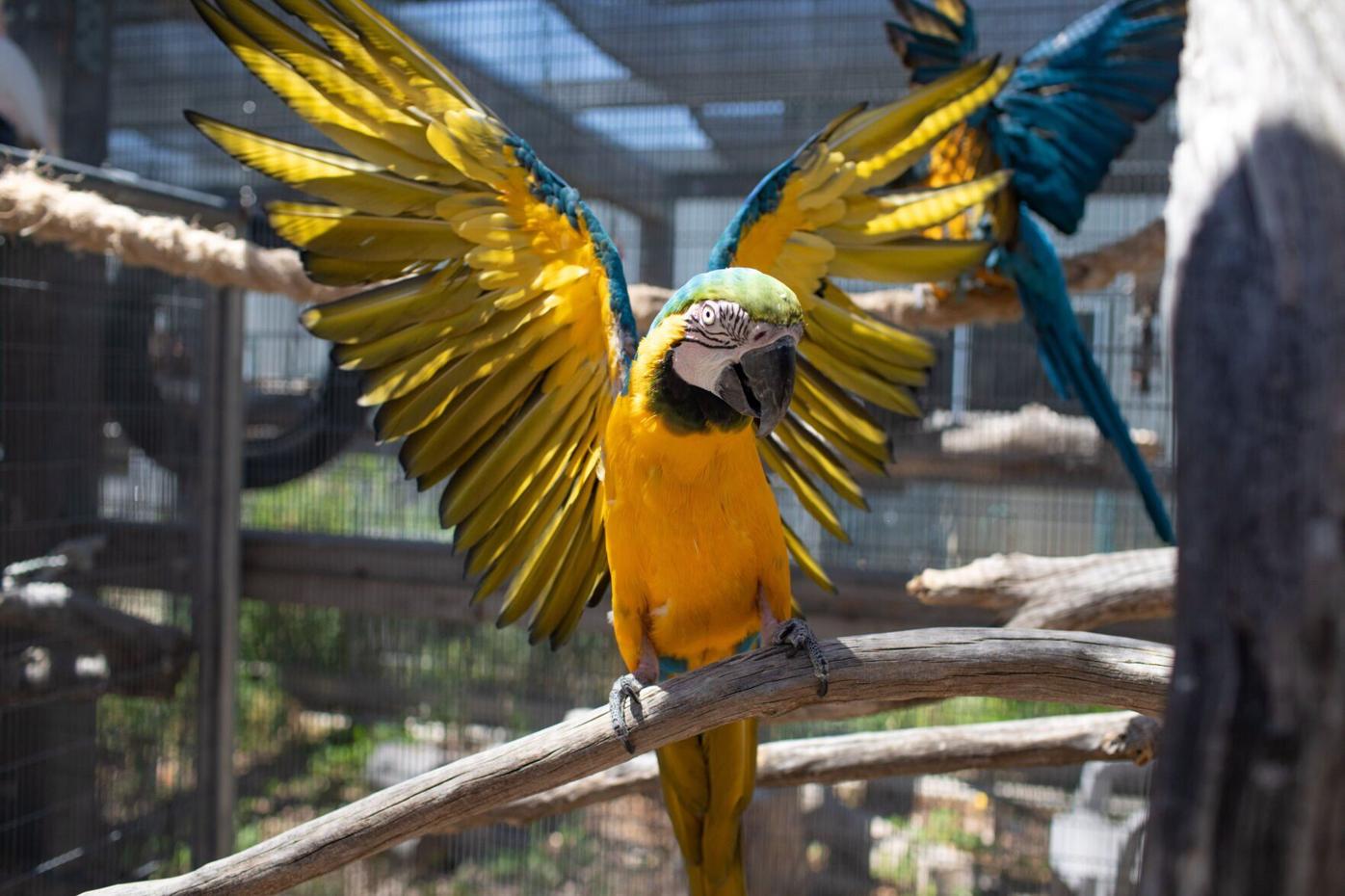
A blue and yellow macaw shows off its colorful wings at the Gabriel Foundation.
photos by John Stember, The Gazette

A blue and yellow macaw shows off its colorful wings at the Gabriel Foundation.
Large metal cages line the lot, home to rainbow-colored macaws, snow-white cockatoos with expressive fluffy crests, sunny little cockatiels and jewel-colored conures. Some cages contain only one bird — the sassier ones who don’t always play well with others. Other even larger enclosures farther back on the property allow birds space to fly and roam, nestle with each other and play, or investigate the strings of brightly colored hanging toys used for mental stimulation.
By day, they bask, amid regular water mistings when the temperatures climbs, and by midafternoon they’re escorted back inside their generously sized aviaries. They begin to mellow as the sun sets and settle in with their buddies to wait for their keepers’ arrival at 7 a.m.
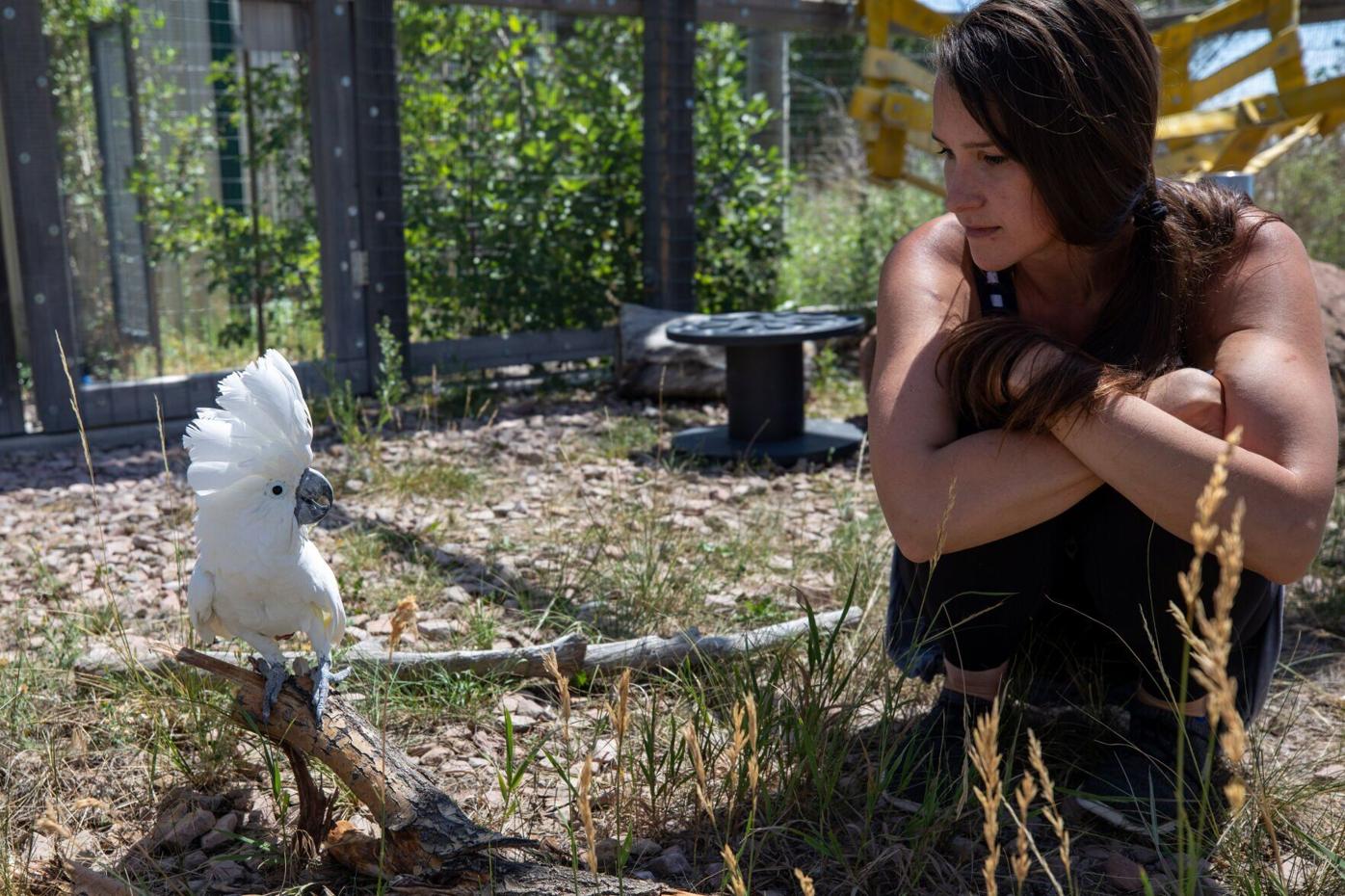
A cockatoo and Kimberly Pierson share a private conversation at the Gabriel Foundation on Saturday, August 6, 2022. The foundation is a parrot sanctuary home to over 300 different birds with Macaws, Cockatoos, African grays, Amazons, and many more species. Because of parrots lengthy lifespan, many people aren’t up to taking care of them for their entire lives.
John Stember/The Gazette

A cockatoo and Kimberly Pierson share a private conversation at the Gabriel Foundation on Saturday, August 6, 2022. The foundation is a parrot sanctuary home to over 300 different birds with Macaws, Cockatoos, African grays, Amazons, and many more species. Because of parrots lengthy lifespan, many people aren’t up to taking care of them for their entire lives.
“Once you become a bird person, you’re inherently changed,” said Pierson, whose blue and gold macaw often perches on her shoulder as she works, intently nibbling anything he can get his beak on: her face, hair, shirt, sunglasses. “Even if you start with a small bird, your life becomes changed once you get attached to them. You can’t not have them in your life.”
Little dramas, resentments, jealousies and love affairs pepper the crowd of 330 parrots and a few pigeons. There’s Max the macaw and his unrequited crush on his cage mate, Madison, also a macaw, who shrugs off his amorous advances. Heartbroken staff members keep trying to introduce him to other birds who might crush on him back, but to no avail.
And staff members also feel compassion for forlorn Iggy, an endangered blue hyacinth macaw who won’t be adopted out due to his endangered status. His best mate was recently adopted, but luckily the adopter works at the rescue and can bring the bird to work to spend quality time with Iggy.
Backyard gangsters: Loving, loathing, and living with raccoons
Birds are like people. Sometimes they like other birds, and sometimes they don’t. When they do make friends, staff puts them together in their own area. And if two birds appear on the verge of falling in love, all the better.
“We try to pay attention if they unexpectedly meet another bird or are flirting,” Pierson said. “It’s darling to watch a parrot fall in love. They head bob and dilate their eyes. We’ll let them hang out outside and play together. Eventually we might make them cage mates indoors. You want to make their lives fun.”
History of the foundation
Gabriel’s founder, president and CEO, Julie Weiss Murad, can trace her love of birds back to a third-grade teacher who had a collection of bird miniatures. She also remembers ogling the cardinals and blue jays she spied in her Chicago suburb neighborhood, and the budgie, a small parakeet, she owned as a child. Later, it was a large parrot her in-laws gave her as a wedding gift in the early ‘70s when she lived in Kuwait, where birds are treasured animals.
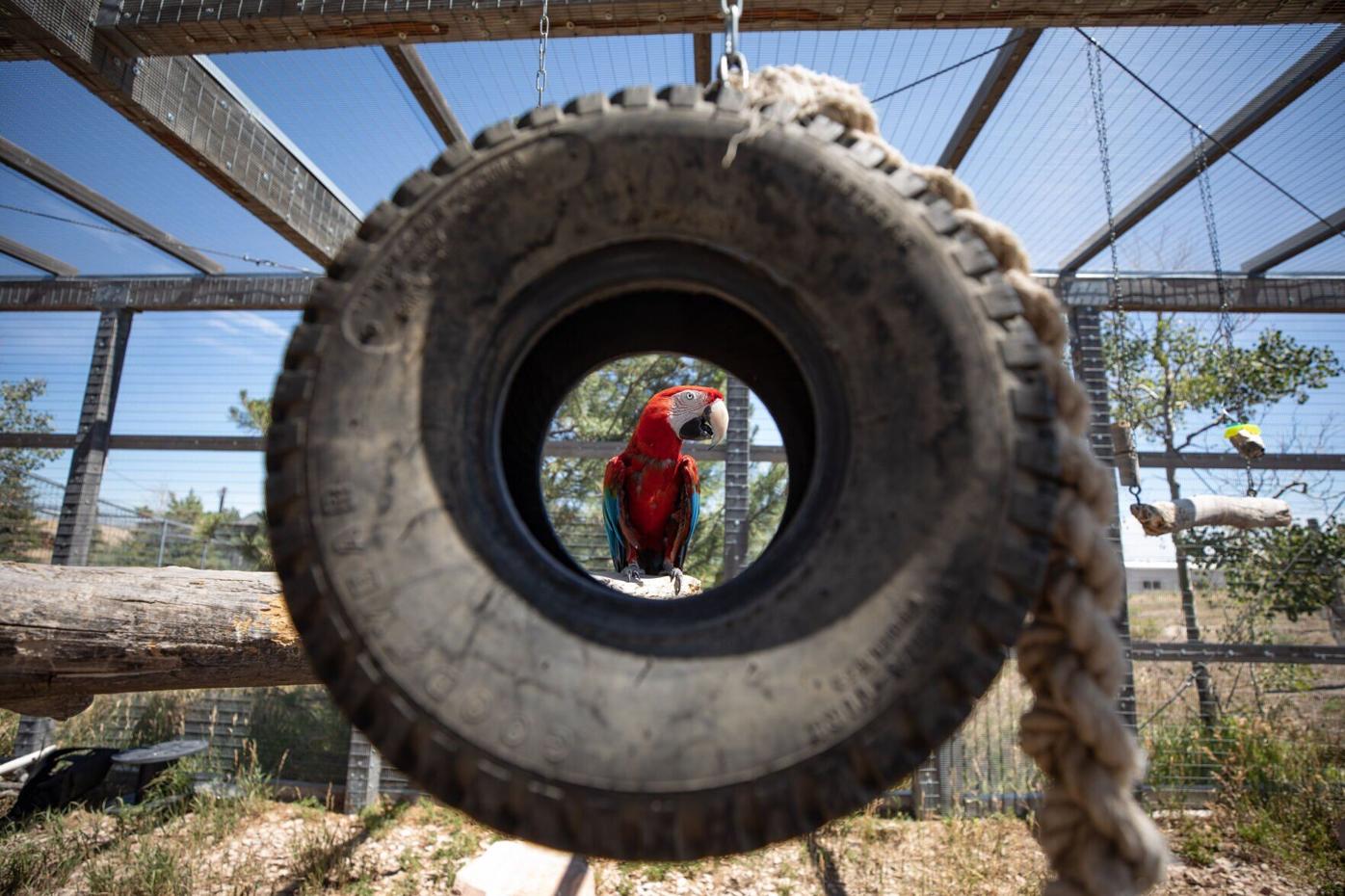
Despite what you might think, many of the larger parrots at the Gabriel Foundation get around by using their feet rather than their wings.
John Stember/The Gazette

Despite what you might think, many of the larger parrots at the Gabriel Foundation get around by using their feet rather than their wings.
“I’ve been around birds longer than I haven’t,” Murad said. “I loved to watch them in flight and the sounds they make, their body language, their behavior has always been special to me.”
After returning to the U.S., she owned The Birdbrain in Denver in the early ‘90s, a store that sold enrichment items for birds. Around that same time, she acquired Gabriel, a blue hyacinth she’d been longing to add to her flock. But her new baby, less than 2 years old, got sick and died in less than 24 hours due to an issue in his small intestines. Vet care for parrots was not as extensive back then.
“His death was something that was a bit unusual, but not unexpected because of the way birds were hand-raised at the time,” Murad said. “I felt bereft and heartbroken and wanted to turn the pain of my loss into a rite of experience. I felt like I could help people.”
Murad, now a nationally known human and parrot behavioral consultant, lecturer and author, started the nonprofit parrot welfare organization in 1995. She lives on the property that, along with the birds, is home to a menagerie that includes horses, donkeys, llamas and other creatures who needed homes when owners could no longer care for them.
The adoption process
The parrots make their way to the shelter through various avenues, including animal shelters, where they’re often dumped, and from people who can no longer care for the bird due to any number of reasons. About half the foundation’s parrots are sanctuary birds, meaning they’ll live out the rest of their lives at the rescue.
Inside the main building, adoptions manager Melissa Heath adopts out about one bird every week, and keeps a running tally on a white board of the beloved flock. A little over halfway through July, and 69 birds have been adopted this year, while 173 are available.
IMAX film hopes to raise awareness of largely unknown North American ecosystem | Bird Call
Years ago, 600 to 700 birds lived at the rescue, but staff have worked to get that number down so they have time to work with the more difficult parrots, helping them get used to humans so they have a better chance at finding a home.
In her early years with the rescue, Heath had her sights set on adopting an African grey, but a certain white umbrella cockatoo had a different plan.
“Lady Anna chose me when I started working in the building she was in,” Heath said. “She would always fly to my shoulder to visit me. She didn’t do that to anybody else.”
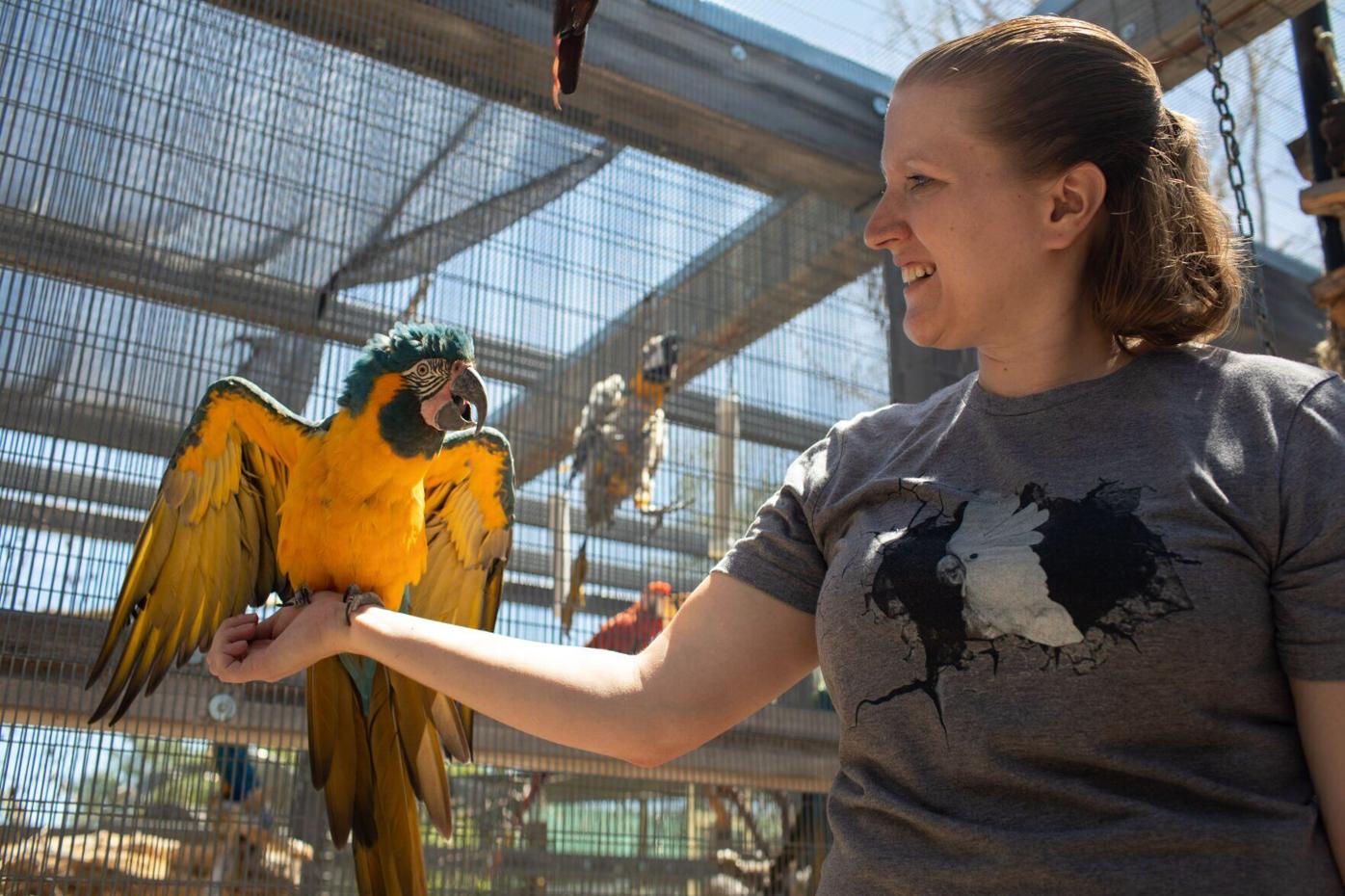
Gabriel Foundation staffer Melissa Heath lends a hand to a blue and yellow macaw.
John Stember/The Gazette

Gabriel Foundation staffer Melissa Heath lends a hand to a blue and yellow macaw.
Heath was the chosen one. And now she makes ornate handmade dresses for her little, white 23-year-old shadow, whom she calls a “fashionista.” She’s got about 120 costumes, including a cowgirl dress, and her extensive wardrobe can be seen, along with Heath’s other cockatoo, Miss Pearl, who isn’t quite as enamored with getting dressed up, on Instagram at living_with_cockatoos.
“She’s been featured in a couple of magazines because birds don’t tend to like to dress up and she does,” Heath said. “She’s very protective of her wardrobe, and she’ll actually go after other birds if I try to put clothes on them.”
Adopting a parrot will look quite a bit different than adopting a dog or cat, unless it’s a small bird, such as budgies, cockatiels and pigeons. Those are same-day adoptions. For anything bigger, adopters can expect a minimum of five weekly visits after filling out an application and doing a pre-adoption interview via Zoom, where staff will try to get a feel for what birds might fit their lifestyle.
“Birds are more complex than dogs and cats,” Heath said. “Their behaviors require more training for people. We also make sure we’re going over diet and enrichment. With dogs, they bark, but that’s a whole other level of sound compared to parrots screaming. And their beak does a lot more damage, too.”
Pierson always encourages potential bird owners to not fixate on getting baby birds from breeders, and to give older parrots a chance. Large birds live a long time, upwards of 60 to 80 years, depending on their care. And it’s important to note that much like humans, they also go through teenage years.
“One of the nice things about adopting an adult parrot is their personality is already set,” Heath said. “Especially the cockatoos and probably the macaw, they go through teen years where their personality kind of changes. They start to act out. A lot of our male umbrella cockatoos came in when they turned 14 or 15.”
Nature’s clean-up crew: Meet the vultures at Cheyenne Mountain Zoo
The adoption process continues after the parrot goes home with its new owner. Follow-up reports are required after 24 hours, three days, three weeks and three months. And all adoptions come with free lifetime behavioral consults with the foundation’s two behaviorists. For a bird who’s lived with other birds for years, it can be stressful to be the only bird in a new environment.
“If you have your heart set on a big old cockatoo and you live in a condo, or you’ve got a full-time job or you’re at school or you’ve got a big family, that might not be the best choice because of the time involved,” Murad said. “Take into consideration your home environment, and the impact of that bird on your life and the other people in the home.”
For the love of a flock
Birds can snuggle their way into your heart much like any golden retriever or tabby cat. People might question the likelihood of a deep connection between human and bird, but everyone at The Gabriel Foundation knows otherwise.
Murad recently lost a cockatiel she’d had for 25 years. It’s a parrot many might overlook because they’re not as big and sparkly as some of their larger relatives.
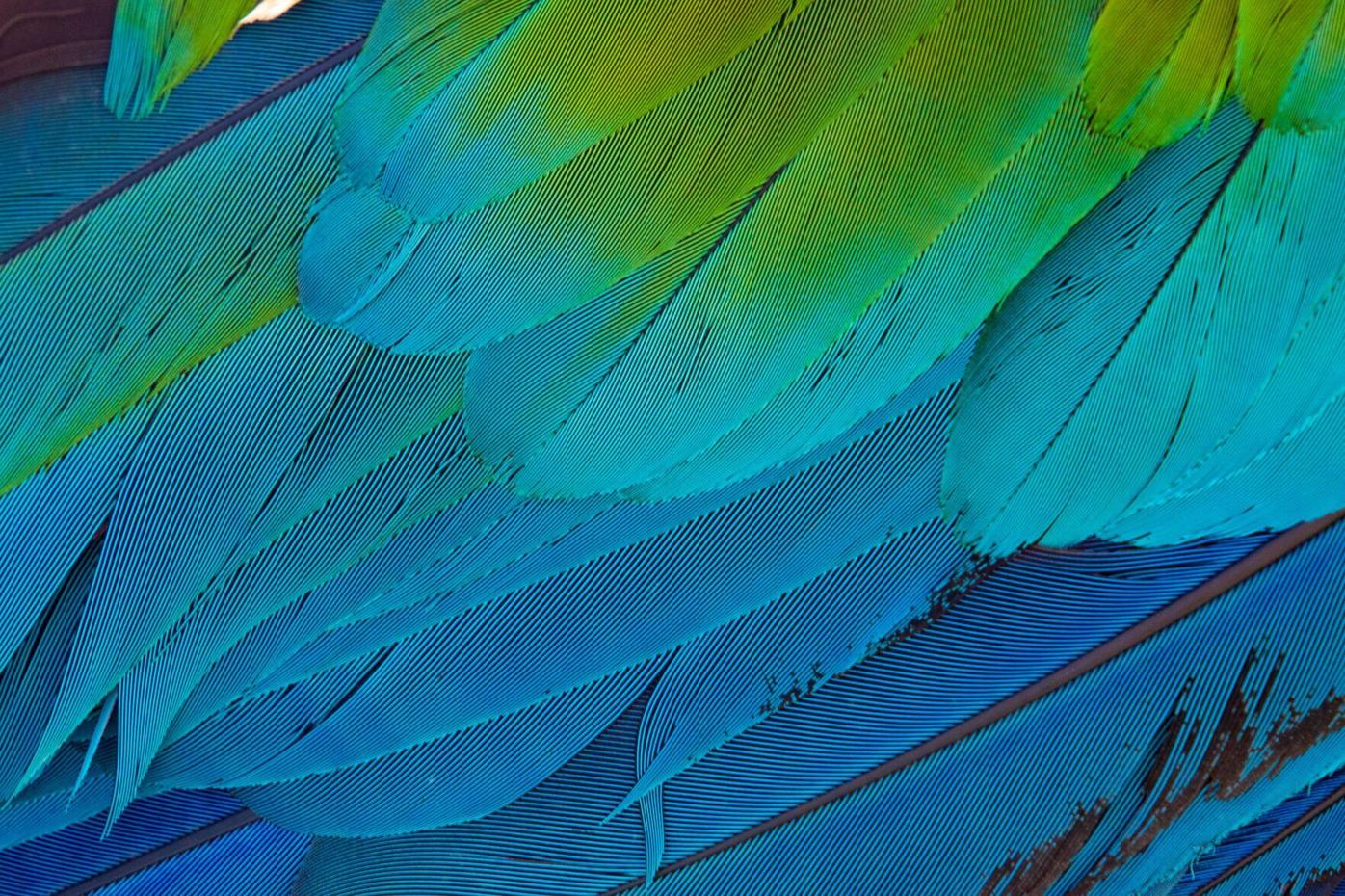
A close-up of the plethora of colors from a red and green macaw at the Gabriel Foundation.
John Stember/The Gazette

A close-up of the plethora of colors from a red and green macaw at the Gabriel Foundation.
“We shared a lifetime,” she said. “Here’s a little thing that weighed 100 grams that brought so much joy and pleasure into my life. He will be very much missed.”
Marianne Batchelder also knows well that particular love, and gravitates toward the older birds. She’s volunteered at the nonprofit for eight years, regularly adopting parrots along the way. Right now she has seven, five of which came from the rescue. And she’s had one, who didn’t come from the rescue, for 24 years, almost the entire life of the bird.
They each have their own distinct personality, and they’re smart — Murad says they’re considered to have the intelligence of a 5-year-old. Plus, there’s the challenge, which Batchelder appreciates.
“These aren’t dogs and cats that have been domesticated for 10,000 years and have adapted to living with us,” she said. “These (parrots) aren’t wild animals, but they’re only one or two generations removed from their wild ancestors. We have to come to their level. They’re not as predictable as a cat or dog. It’s a different interaction than you have with other pets because they’re so different from us.”
Bird Call: What to do about backyard thugs?
For Heath, a parrot’s long life is appealing, as well as being able to tote Lady Anna and Miss Pearl around her neighborhood in their outfits and educate people about their care.
“It’s almost like having a kid, but you don’t have to worry about sending them off to college or changing diapers,” she said. “When I started volunteering here and then asking for a job, I didn’t expect to fall in love with birds the way I did.”
Contact the writer: 636-0270
Contact the writer: 636-0270





